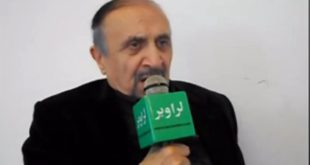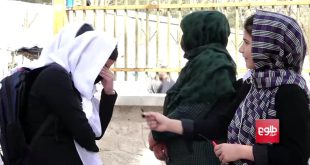Controversial Newscasts: A Media Beset by Anomalies or Instruments of Propaganda?
The CIA has hired 300 persons to be trained as journalists: Global Research.Com
An accredited journalist once wrote that To Tell the Truth is not a Crime, A statement for serious consideration and evaluation while reading major-media renditions of the US/Afghan War. !t is not uncommon for those who write about the war in Afghanistan, whether in terms of the history of the Soviet Afghan/War and occupation, controversial celebrity, or current political development, to be alleged to harbor some covert conspiracy or hidden agenda, beholden to any one of a myriad of special interests, or this or that political party and or government/agency.
Over the decades, books and articles addressing the collaboration of certain members of Afghanistan’s minority factions with the Soviet invaders have been characterized as such. But a majority of credible writers and historians rely on citing reliable and easily accessed sources for their information as the foundation for their articulated viewpoints and conclusions. In short, reliable sources that lend themselves to substantiation are the overarching imperative and life-line for journalists and authors. Well-cited articles, books and research papers are therefore guilty only of ‘conspiratorial excellence to commit Journalism.’
From the Archives:
The nom de guerre ‘Lion of the Panjsher’, gratuitous celebrity characterization conferred upon the late Ahmad Shah Massoud, portends a man of unfaltering courage, a consummate, storied guerrilla leader possessed with the burning desire to serve country and flag. But a very different kind of man was the reality. Emerging from our exhaustively researched-pages in engaging detail, we find a man consumed with ethnicity, power and personal ambition during the Soviet/Afghan War and the bloody aftermath.
Notable are the comments of a senior intelligence officer as quoted from the introduction and text of the Pashto translation of Limited Contingent by Pardes Mosafir, the memoirs of former Soviet General Boris Gromov (1996) who served as commander of the Soviet Fortieth Army in Afghanistan and as originally published in Mashovsky Comsomol newspaper, 13 April 1994, and The Hand of Moscow, by former KGB Director Leonid Shebarshin, 1992, pp. 177-214:
‘But if you want the truth, it is for a long time Massoud was connected with us, and was the agent of our influence. For about a year our officials held talks with him, and they took joint decisions. And for a long time he did what we told him ((Mosafir VI). Ahmad Shah Massoud observed the injunctions of Islam in his daily life, but it was known that he drank alcohol in the company of his close friends’.
‘Ahmad Shah Massoud took care of the common people, and he loved them. Among the Afghans this commander was more popular than others. That was why the command of our contingents was interested in attracting his cooperation and by so doing forestall bloody encounters from happening in Panjsher.The efforts of the Fortieth Army at last produced the required results. In 1982 we reached our goal: we established such strong ties with Ahmad Shah Massoud which remained intact until the Soviet Army withdrew from Afghanistan.’
‘In Afghanistan, our military presence developed with Ahmad Shah Massoud in the course of the years (we were there). Nevertheless, the command of our limited contingents did not overlook the armed activities of his bands. In 1982 an agreement was concluded between Ahmad Shah Massoud personally and representatives of the Fortieth Army, according to which Massoud undertook to prevent any armed activity against the Soviet military convoys in Southern Salang over which he alone controlled.’
‘Ahmad Shah Massoud was compelled to agree to such an agreement because of his lack of logistics and weapons……According to the agreement, Ahmad Shah Massoud ordered all his bands to refrain from military engagements with the forces of the (Kabul) Government, and to direct all their power against the bands of the Islamic Party (headed by Gulbuddin Hekmatyar.’
Panjsher Offensives:
But what of the fabled Panjsher offensives: Were these the punishing, celebrated battles as characterized by foreign correspondents, or staged media-events in which the Western press portrayed Massoud as the sagacious and consummate icon of the Afghan Resistance? Though rarely discussed with foreign journalists, it was well-known amongst a number of Resistance commanders that Massoud often staged battles with the Soviet 40th Army, pretending to fight the invaders in order to forestall critical examination and provide cover from exposure of his storied but inauspicious military prowess and the fact that he was in reality collaborating with the Soviets, protecting their lines of supply along and through the precipitous and redoubtable Salang Highway and Tunnel, the choke point of Soviet logistics.
During an interview with Yuri Korbert, a Soviet/Afghan War veteran who had been assigned to the Panjsher area and in response to my query about the Soviets fighting against Massoud, he responded: ‘No, we didn’t fight with him.’ Internationally syndicated journalist, Eric S. Margolis also addresses Massoud’s military record in his best-selling book ‘American Raj, Liberation or Domination, Resolving the Conflict between the West and the Muslim World,’ Margolis:
‘During the ten-year jihad against the Soviets, the Tajik military leader Ahmad Shah Massoud was lionized in the West as an heroic anti-Communist mountain warrior…the ‘Lion of the Panjsher.’ In reality, he had long secretly collaborated with the Soviet KGB, a fact recently revealed in the memoirs of retired Soviet intelligence officers from KGB and GRU military intelligence. While pretending to fight the Soviets, Massoud actually devoted his main efforts to combating the Pashtun Mujahideen, thwarting their efforts, backed by Pakistani intelligence agents, to blow up the strategic choke-point of Soviet logistics, the Salang Tunnel. Massoud also intrigued to convince Moscow to ditch its current puppet ruler, Najibullah, and make him ruler of Afghanistan.’
The extreme difficulty encountered by the 40th Army in deploying men and heavy equipment in addition to conducting combat operations in the rugged, formidable mountainous topography of the Salang area, elicited this often-quoted comment from Soviet 40th Army Commander, General Boris Gromov:
‘The army of famed Jihadi Commander, Ahmad Shah Massoud, could convert the area into a graveyard for the Russian troops by only throwing rocks.’
Cognitive tactical awareness by the wily general of the inherent nightmare scenarios encountered in mountainous warfare, invaluable combat experience gained from a century or more of fighting guerrillas in vast, mountainous Central Asia, induced the Soviet general to seek a solution. General Gromov went on to say that they had immediately met with Massoud and signed an agreement with him: this constituted the heralded 1982 agreement. As history avers, however, the first of such cooperative agreements took place in 1980.
The late Ahmad Shah Massoud was portrayed by both witting and unwitting journalists as a ‘Freedom Fighter’ who continually and remarkably outwitted and defied the venerated and collective might of the Red Army, a military colossus supported and advised by the fabled intelligence apparatus, the omnipresent KGB. At that time, the USSR was one of but two of the largest land armies in the world. This mythology, however, was contrary to the actual as opposed to rhetorical and often theatrical warfare, war as articulated and exposed in the blunt and sobering memoirs of Soviet Generals’ Boris Gromov and Alexander A. Liakhovski, who wrote in their respective memoirs that ‘Massoud did what we told him to do for the entire time we were in Afghanistan, we (Fortieth Army) could crush Massoud at any time.’
KGB Director of Foreign Intelligence, Leonid Shebarshin writes in his memoirs that a certain engineer named Isaac would boast at the end of 1988 in the Saudi city of Taifa that information about the impending military offensives against the Panjsher redoubt had come not from Afghan but from Soviet sources:
‘Marshal Sokolov couldn’t but have known about the close conspiratorial contacts between his intelligence officers and Ahmad Shah…and given the circumstances, his knowledge of this couldn’t but lead him to reflect:
Panjsher: The most major and heralded operation of the Afghan War was a fraud. It turned an insignificant leader Ahmad Shah into a figure of national importance, made him internationally known, and unleashed a flood of money and arms from the USA and Europe to all the respective Resistance organizations. The fruits of the Panjsher operations, or rather their complete fruitfulness, made themselves felt more than once during the time our army remained in Afghanistan.’
Soviet journalist Vladmir Snegirev also questioned the veracity of media reports regarding the heralded attacks against the Panjsher enclave:
‘Even before, I’d suspected that our victories in Panjsher, where by the way Marshals Sokolov and Axomeev, and army general Varennikov directed our forces, were an extensive forgery’. This was confirmed recently by the publication of the notes of the former head of the KGB’s foreign intelligence section, L. Shebarshin.
In a ‘secret report’ to Defense Minister Dmitri T. Yazov, dated August 1998, General Valentin Varennikov wrote:
‘In our view, the adoption of the proposal of the president about involving the Fortieth Army in battles with A. Shah could place our troops in an extremely serious situation during the second stage of our withdrawal from Afghanistan. A.Shah has categorically prohibited his formations from waging combat against Soviet troops which they vigorously observe. In the future Ahmad Shah might grow into an important political figure with whom the Soviet Union, in all probability, will have to cooperate and it would be to our advantage to keep him as an ally and not an enemy’.
Notes:
Supporting Documentation:
Boris V. Gromov, Limited Contingent, Moscow: Progress Press, 1996, pp. 188-197. Translation: Professor Ian Helfant, Department of Slavic Languages, Harvard University, p.40.
A.A. Liakhovskii, Planya Afgana, Moscow: Iskon 1999, pp. 485, 486, 630, 674. Translation: Gary Goldberg for Cold War in History Project, (CWIHP) Washington, D.C., and Dr. Quyyum Kochai.
Leonid Shebarshin, The Hand of Moscow, Moscow: Progress Press, 1992, pp. 177-214. Translation: Professor Ian Helfant, Department of Slavic Languages and Literature, Harvard University.
Anatoly Snegirev, Moscow, ‘Among my Agents were Soviet Generals’, Trud, 22 January 1992:pp. 1-2.
Valentin Varennikov,’a secret report from General Valentin Varennikov to Soviet Defense Minister General Dmitri T. Yazov’, dated August 1988.Translation: Gary Goldberg for Cold War in History Project, (CWIHP) Washington, and D.C. Bulletin 14/15, pp. 263-264.
Main Intelligence Directorate (MID) of the General Headquarters, USSR Armed Forces, Title: The Lion of the Pandjsher, Article no. 18, (No. 882/83-3-5-77, Fond 80, Perechen 14, Document 77) translation of excerpts by Elena Kretova, Information Services, Moscow.
M. Siddieq Noorzoy, Communications by Members of the Afghan Diaspora about Events in Afghanistan to US Leaders, the UN and World Leaders, 2013, September 21, 1979-October 7, 2013.
Bruce G. Richardson, an interview: with Soviet/Afghan War veteran Yuri Korbert, 28 November 2005.
Dr. Nabi Misdaq, Afghanistan: Political Frailty and External Interference, 2006, pp. 162, 208, 210, 212, 330n.
Eric S. Margolis, ‘American Raj, Liberation or Domination, Resolving the Conflict between the West and the Muslim World, published 2008, p.196.
Sami Yousefzai, ‘Ex-Soviet Commander unveils Massoud’s Secret Pact’, Weekly Mirror International, 5/23/01.
Pardes Mosafir, Pashto Translation (1996) of ‘Limited Contingent’, by General Boris Gromov, Commanding General, Soviet 40th Army Afghanistan, pp. VI, 264-266, originally published by Mashkovsky Comsomol, 1996.
Snowden Edward, To Tell the Truth is not a Crime, Spiegel, November 4, 2013
In the wake of the hire, training and deployment of 300 journalists by the CIA, inviolable reporting is fraught with historic inaccuracies and in constant danger of becoming an instrument of propaganda by the superpower leadership seeking a more favorable rapport with their voting constituents. Thus rests the case for honoring honest and truthful reporting before the general public, also known as: the ‘Court of World Opinion.’ Bruce G. Richardson
 لراوبر ویب پاڼه لراوبر يو افغان – تازه خبرونه
لراوبر ویب پاڼه لراوبر يو افغان – تازه خبرونه


